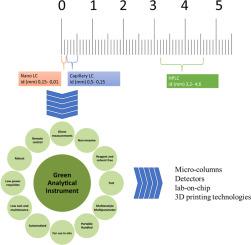使用小型化和便携式3D打印系统的化学分析:我们现在在哪里?
IF 3.2
引用次数: 0
摘要
随着对绿色化学(GC)和绿色分析化学(GAC)的日益重视,人们已经在减少样品大小和简化样品制备过程方面做出了重大努力。同时,正在进行的研究使用于定量分析的仪器配置小型化,符合可持续性原则。一个主要的挑战在于液相色谱系统固有的复杂性,它包括多个相互连接的组件。每个组分都经过小型化处理,在应用于实际样品时,要注意保持分析灵敏度、选择性和准确性。减小流量可以提高表面体积比,从而提高检测灵敏度,这一理论原理进一步推动了人们对小型化系统的兴趣。建立在这个理论基础上,特别是便携性,高效采样和现场分析的目标,创新的方法,如微流体和3D打印已被用于开发紧凑的流体系统。这些技术不仅拓宽了液相色谱的范围,而且开辟了新的领域,如工程组织的药物测试,以及适合太空任务的新设备的开发。本综述旨在全面概述在仪器装置和便携式系统小型化方面所遇到的挑战和取得的进展,包括分析前和分析后阶段。此外,还讨论了可用于lc芯片和小型化系统的三维技术。本文章由计算机程序翻译,如有差异,请以英文原文为准。

Chemical analysis using miniaturized and Portable 3D printed systems: Where are we now?
With the growing emphasis on green chemistry (GC) and green analytical chemistry (GAC), significant efforts have been directed toward minimizing sample size and simplifying sample preparation procedures. Concurrently, ongoing research has enabled the miniaturization of instrumental configurations used for quantitative analysis, aligning with the principles of sustainability.
One major challenge lies in the inherent complexity of liquid chromatography systems, which comprise multiple interconnected components. Each component has been subject to miniaturization, with careful attention to preserving analytical sensitivity, selectivity, and accuracy when applied to real samples. Interest in miniaturized systems is further fueled by the theoretical principle that reducing flow rates enhances the surface-to-volume ratio, thereby improving detection sensitivity.
Building on this theoretical foundation—particularly the goals of portability, efficient sampling, and on site analysis—innovative approaches such as microfluidics and 3D printing have been employed to develop compact fluidic systems. These technologies not only broaden the scope of liquid chromatography but also open new frontiers, such as drug testing on engineered tissues, and the development of new devices suitable for space missions.
This review aims to present a comprehensive overview of the challenges encountered and the advancements achieved in the miniaturization of instrumental setups and portable systems, encompassing both pre- and post-analytical stages. Furthermore, a discussion on 3D technologies available for LC-chip and miniaturized systems was also presented.
求助全文
通过发布文献求助,成功后即可免费获取论文全文。
去求助
来源期刊

Journal of chromatography open
Analytical Chemistry
CiteScore
2.50
自引率
0.00%
发文量
0
审稿时长
50 days
 求助内容:
求助内容: 应助结果提醒方式:
应助结果提醒方式:


